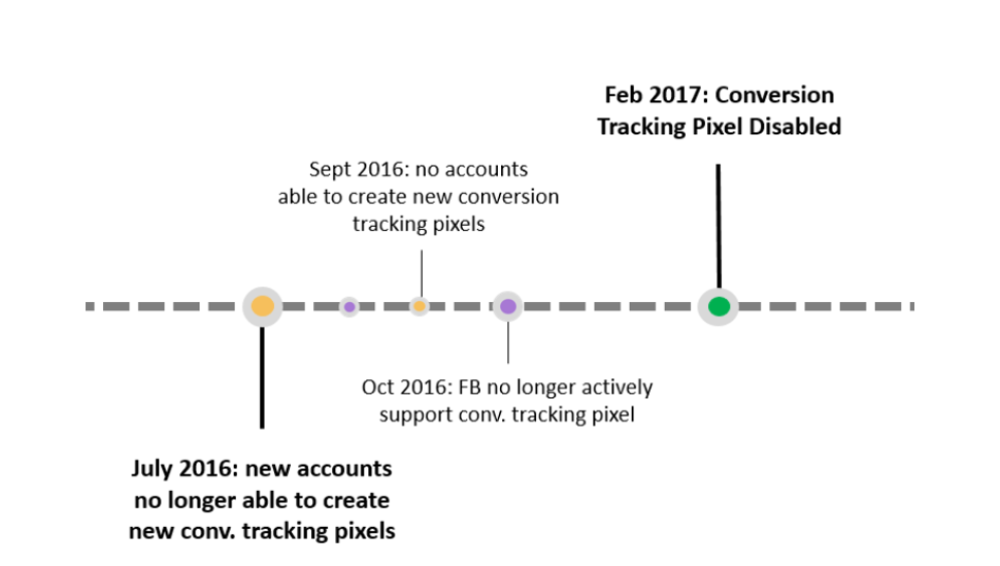Stay Successful at Measuring Success with Facebook: The Demise of the Conversion Pixel
12 Jan 2017

One of the best things about paid media campaigns is the ability to directly measure their impact and judge performance. In most cases, this is made possible by some kind of pixel, and Facebook is no exception. However, 2016 saw Facebook completely change their tracking implementation, and without the right pixel in place, this year could see you lose visibility over user behaviour on site altogether. Read on to gain an understanding of the key differences between the old and new pixel set-up, and to ensure you’ve got everything in place to start making the most of all those improvements Facebook has made.
What's the Difference?
Facebook’s primary tracking tool, until last year, was the Conversion Tracking Pixel. Its set up was comparable to that of DoubleClick floodlight tags, in that you are required to implement multiple pixels for each action you want to track. In addition to that, there was a separate Custom Audience Pixel which had to be implemented for building any remarketing lists.
As you can imagine, that meant some advertisers were having to deal with a whole lot of pixels. They were time-consuming to produce & implement, and difficult to manage.
But Facebook have significantly simplified the whole process by producing the Facebook Pixel: one pixel to rule them all, one pixel to find…. sorry I mean one pixel for conversion tracking and custom audience building. Instead of dozens of pixels needing to be implemented on different areas of your site, you now only need to produce on piece of code to go on every single page. From there you can then create conversions and remarketing lists to your heart’s content. The only instances where additional code will be needed is for tracking revenue, or if you’re implementing dynamic product ads.
If You're Still Using the Conversion Tracking Pixel...
…then you need to make some changes asap. Not only have Facebook created a new tracking, system, they’re also depreciating the old one. Over the course of last year, they’ve slowly tried to ween people off the Conversion Tracking Pixel with a string of changes.
In 2016, a lack of the new Facebook Pixel only meant you were missing out on newer list building opportunities and Facebook support. But from February 15th onwards, the old Conversion Tracking Pixel will stop working and you’ll no longer be able to track on site behaviour using it (historical data from before its depreciation will remain visible in the interface.
Creating the new Facebook Pixel
If you haven’t yet got the Facebook Pixel in place, set up is very simple. Just go to the Tools bar within your Facebook Ads Manager account, and select Pixels under Assets, from there, at the click of a button, you can create your new pixel and then apply it to every page of your site.
What's So Good About the New Pixel?
Creating remarketing lists in Facebook without the new pixel is not impossible; in fact, you can create several lists without any pixel whatsoever:
- Customer file lists: created by uploading CRM data into the Facebook interface which is then hashed and matched with Facebook users
- Engagement lists: these are a relatively new feature, whereby you’re able to create lists of users that have engaged with ads you’ve previously served on Facebook. For instance, you could make a list of all users who interacted with the canvas ad you ran in your last campaign, in order to target them again with a follow up
It’s the website traffic and app activity lists that require the presence of a pixel/additional coding. Aside from eliminating the need for multiple pixels and simplifying the entire tracking/remarketing process, there are also some options with the new pixel that weren’t possible before.
One of the newest options is reminiscent of Google Analytics: the ability to create lists of users who’ve spent a particular amount of time on site. This could help advertisers to hone in on the most engaged users that have previously visited their website. Plus of course, there are the familiar site visitor & custom combination lists that we all know and love.
Conclusions
Without the ability to accurately measure the success of your campaigns, you may as well be throwing money down the drain. And with, on average, less than 5% of visitors to your site completing the action you want on their first visit, remarketing is a vital tool for any advertiser. The new Facebook Pixel brings these capabilities together in one simple solution, so make sure you’ve got yours implemented before February 15th 2017!
To read this blog written by Laura Collins on the Periscopix website, please click here.

Please login to comment.
Comments